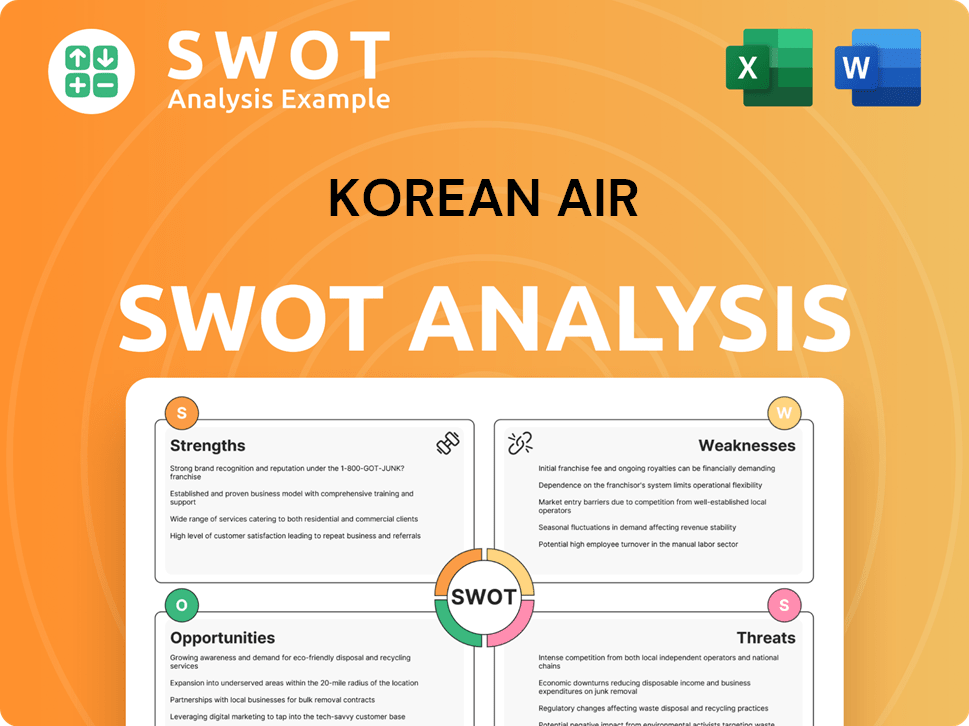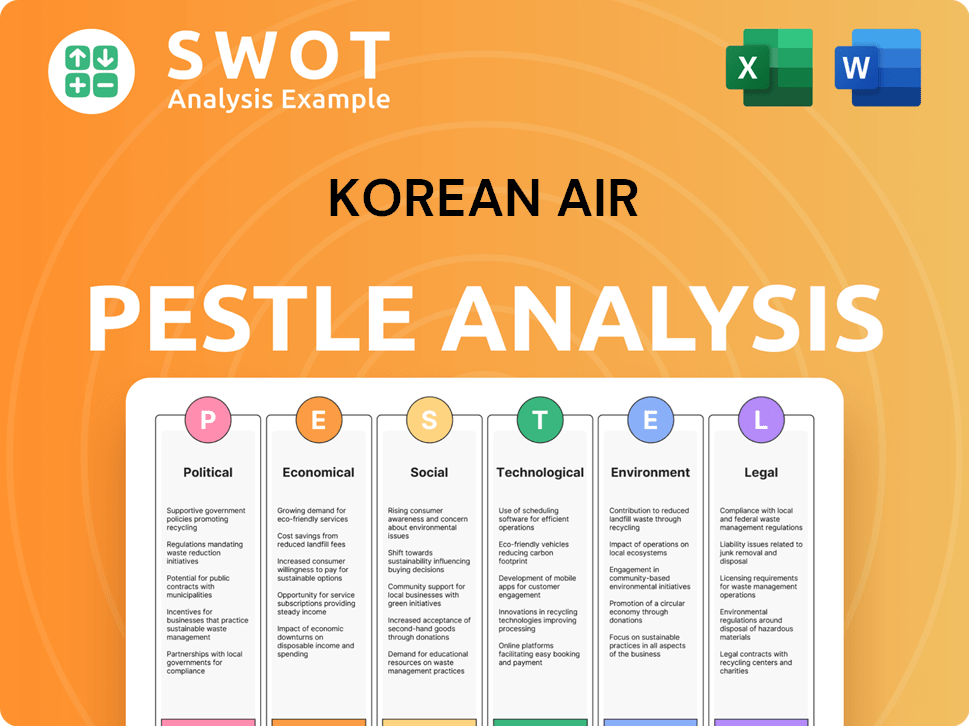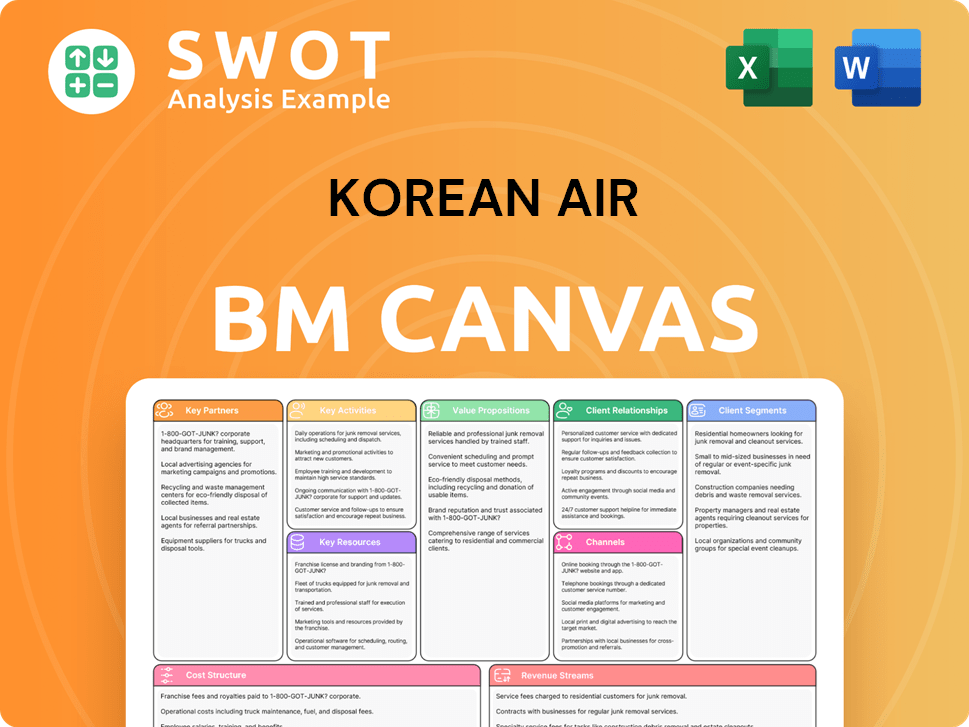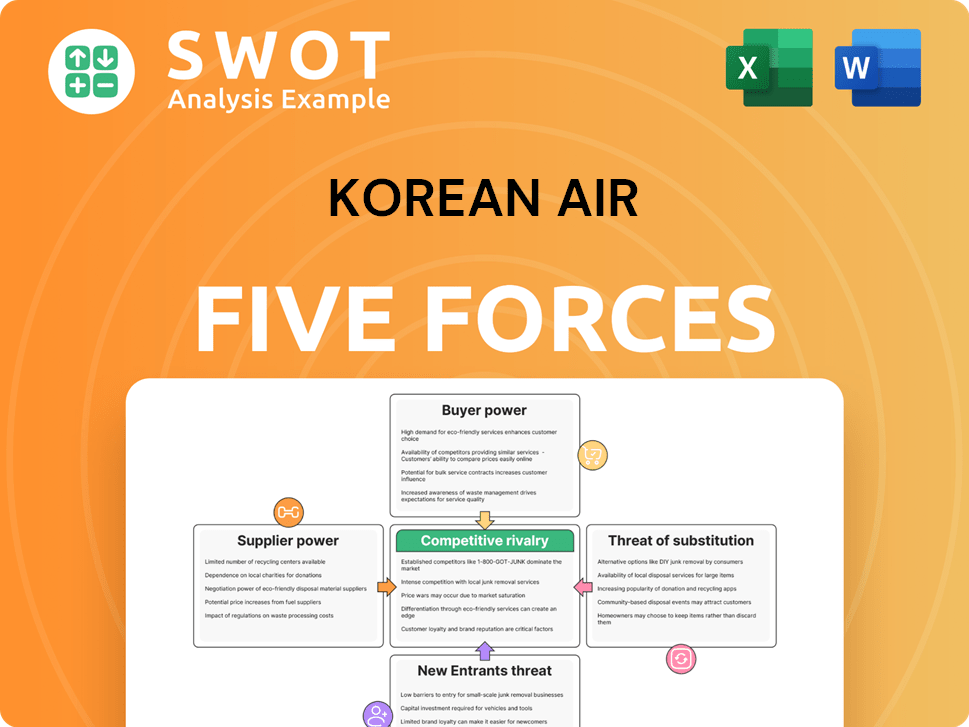Korean Air Bundle
How Does Korean Air Soar Above the Competition?
Korean Air, South Korea's flag carrier, isn't just an airline; it's a global powerhouse that has consistently demonstrated remarkable resilience. In 2024, it reached record-breaking revenue, showcasing its strength in a competitive market. This in-depth analysis explores the inner workings of Korean Air, revealing its strategies and financial performance.

From its extensive Korean Air SWOT Analysis to its diverse revenue streams, understanding the Korean Air business model is crucial. We'll explore its Korean Air operations, including its impressive Korean Air fleet and expansive Korean Air routes, alongside its Korean Air history and strategic moves, particularly the recent acquisition of Asiana Airlines. This examination offers essential insights for anyone interested in the aviation industry, including how Korean Air manages its flights and handles delays and cancellations.
What Are the Key Operations Driving Korean Air’s Success?
Korean Air's core operations are centered on providing comprehensive air transportation services, encompassing passenger and cargo segments, alongside specialized maintenance and engineering. The airline serves a diverse customer base, from individual travelers to businesses requiring efficient logistics solutions. Its passenger services offer various cabin experiences and ancillary services, with a strong focus on enhancing passenger comfort and the overall travel experience.
The airline's business model is designed to maximize revenue through strategic route management and service diversification. For instance, in Q1 2025, Korean Air focused on maintaining capacity on high-demand routes and expanding charter flights, driven by sustained long-haul demand and the anticipated recovery in the China market. This approach is supported by a commitment to operational efficiency, fleet modernization, and strategic partnerships.
Korean Air's dedication to operational excellence and customer satisfaction is evident in its continuous investments in technology and service enhancements. The airline's strategic alliances and partnerships further strengthen its global network and enhance its ability to provide seamless travel experiences for its passengers and efficient logistics solutions for its cargo clients.
Korean Air offers various cabin experiences and baggage options, with a focus on enhancing passenger comfort. In Q1 2025, the passenger business generated KRW 2.4355 trillion in revenue, a 4% increase year-on-year. The airline plans to maximize passenger revenue by maintaining capacity on high-demand routes and expanding charter flights.
Korean Air operates one of the world's largest cargo divisions, leveraging a fleet that included 33 cargo planes as of March 2024. The cargo division recorded KRW 1.0540 trillion in revenue in Q1 2025, a 6% increase year-on-year. The airline extends its cargo handling contract with Vienna International Airport until the end of 2028.
Korean Air is committed to fleet modernization, with new aircraft deliveries expected to be completed by 2033. The airline's strategic partnerships, such as its collaboration with Boeing and GE Aerospace, ensure access to advanced technology. Korean Air is also enhancing its customer service through a partnership with Amazon Web Services (AWS) to develop an AI Contact Center (AICC) platform.
Korean Air maintains extensive alliances, including its founding membership in SkyTeam and SkyTeam Cargo. These alliances facilitate global connectivity and seamless travel experiences through codeshare agreements with partners like Delta Air Lines and WestJet. For more insights, explore the Marketing Strategy of Korean Air.
Korean Air distinguishes itself through a combination of factors that enhance its operational efficiency and customer service. These include fleet modernization, strategic partnerships, and extensive alliances, all contributing to a superior travel experience and efficient cargo solutions.
- Fleet Modernization: Ongoing fleet renewal ensures fuel efficiency and reduced emissions.
- Strategic Partnerships: Collaborations with leading aerospace companies provide access to cutting-edge technology.
- Customer Service Enhancement: Implementation of AI-driven platforms for improved support.
- Global Network: SkyTeam membership and codeshare agreements expand global reach.
Korean Air SWOT Analysis
- Complete SWOT Breakdown
- Fully Customizable
- Editable in Excel & Word
- Professional Formatting
- Investor-Ready Format

How Does Korean Air Make Money?
Korean Air's revenue streams are primarily driven by its air transport segment, encompassing passenger and cargo services. The company's financial performance is a key indicator of its operational success and strategic initiatives. In 2024, the company saw record-high revenues, demonstrating its strong market position.
The airline's monetization strategies involve a multifaceted approach, including diverse passenger class options, baggage fees, and other ancillary services. Korean Air focuses on optimizing revenue through dynamic capacity management and service diversification, particularly in its cargo operations. International operations contribute significantly to overall revenue, with a substantial portion derived from the Republic of Korea.
The company's focus on expanding exclusive international routes, such as new flights to Kobe, Lisbon, and Casablanca, and boosting A380 service to Los Angeles, aims to tap into niche markets and reduce competition, thereby boosting profitability. This strategic expansion is a key element of the Growth Strategy of Korean Air.
A closer look at Korean Air's revenue streams reveals the following key components:
- Passenger Business: In Q4 2024, this segment generated KRW 2.3746 trillion, though it saw a 3% year-on-year decline. However, Q1 2025 showed a 4% year-on-year increase, reaching KRW 2.4355 trillion, boosted by strong travel demand.
- Cargo Operations: This is a significant revenue source, accounting for around 40% of total revenue. Q4 2024 cargo revenue was KRW 1.1980 trillion, a 9% year-on-year increase. Q1 2025 saw a 6% year-on-year rise, reaching KRW 1.0540 trillion, supported by consistent demand in key sectors.
- Other Segments: Revenue is also generated from the Aerospace division (maintenance and repairs), in-flight meals, and hotel/limousine services.
Korean Air PESTLE Analysis
- Covers All 6 PESTLE Categories
- No Research Needed – Save Hours of Work
- Built by Experts, Trusted by Consultants
- Instant Download, Ready to Use
- 100% Editable, Fully Customizable

Which Strategic Decisions Have Shaped Korean Air’s Business Model?
The acquisition of Asiana Airlines, finalized in December 2024, marks a pivotal moment in the evolution of Korean Air. This strategic move, which took nearly four years to complete, aims to create a unified airline capable of competing more effectively in the global market. The integration is designed to enhance market share and operational efficiency, particularly in the Asian market.
Korean Air's operational strategies have been significantly impacted by external factors, including delays in aircraft deliveries. These challenges have led to adjustments in flight operations and route planning. The airline has responded by focusing on long-haul and more profitable international routes, particularly from Seoul's Incheon Airport. Furthermore, the airline is navigating macroeconomic uncertainties, such as the strengthening U.S. dollar, which affects fuel costs and cargo demand.
The consolidation of its low-cost carriers, Air Busan and Air Seoul, into Jin Air by December 2025, is another strategic initiative. This move is designed to establish Jin Air as the leading budget airline in South Korea, streamlining operations and enhancing competitiveness in the low-cost segment.
As the flag carrier of South Korea and a founding member of the SkyTeam alliance, Korean Air possesses a strong brand reputation and extensive global network. The airline's brand was recognized as Airline of the Year 2025 by AirlineRatings.com. This strong brand recognition supports its ability to attract customers and maintain a competitive edge in the global aviation market.
Korean Air is investing heavily in fleet modernization to improve efficiency and passenger experience. The airline has finalized a major order for up to 50 Boeing wide-body aircraft, including 20 Boeing 777-9s and 20 787-10s, with deliveries expected by 2033. This $32.7 billion deal aims to enhance fuel efficiency, reduce emissions, and improve passenger comfort. This strategic investment is crucial for maintaining a competitive edge in the long term, as highlighted in Competitors Landscape of Korean Air.
Korean Air's business model is diversified, with its cargo division providing a significant revenue stream. The airline also offers maintenance and engineering services, adding to its operational resilience. This diversification helps the airline manage risks and capitalize on various market opportunities, particularly in the face of fluctuating passenger demand.
Collaborations with entities like Boeing, GE Aerospace, and equity stakes in companies like WestJet and Delta Air Lines, strengthen its global network and connectivity. Korean Air extended its inflight entertainment partnership with Spafax in October 2024. These partnerships are essential for expanding its reach and enhancing its service offerings, providing a competitive advantage in the global airline industry.
Korean Air is actively pursuing sustainability initiatives, including the use of Sustainable Aviation Fuel (SAF). The airline operated its maiden SAF flight in August 2024 and plans to expand SAF usage, aligning with its ESG commitments. This commitment to sustainability is becoming increasingly important for attracting environmentally conscious travelers and meeting global emissions reduction targets.
- The airline is focusing on premium class service.
- Korean Air is expanding charter flights to cater to specific market demands.
- The company is exploring new routes to enhance its network.
- The rebrand in March 2025, signals a new era of leadership and global positioning, aiming to elevate its brand perception as a premium, full-service airline.
Korean Air Business Model Canvas
- Complete 9-Block Business Model Canvas
- Effortlessly Communicate Your Business Strategy
- Investor-Ready BMC Format
- 100% Editable and Customizable
- Clear and Structured Layout

How Is Korean Air Positioning Itself for Continued Success?
As the flag carrier of South Korea, Korean Air holds a prominent position in the global airline industry. Its recent merger with Asiana Airlines, completed in December 2024, has significantly boosted its market share and global reach. Korean Air’s brand value increased by 33% to USD 2.6 billion, as of April 2025, ranking 17th among the top 50 airline brands worldwide.
Despite its strong market position, Korean Air faces several challenges. These include geopolitical and economic uncertainties, aircraft delivery delays, and intense competition on international routes. Operational costs, including depreciation and maintenance, have also impacted profitability, as seen in the 19% year-on-year decrease in operating profit in Q1 2025, even with revenue growth.
Korean Air is a major player in the airline industry, particularly after merging with Asiana Airlines. The merger created a larger carrier with 76 exclusive routes, enhancing its competitive standing against global rivals. The airline is focused on maximizing passenger revenue and expanding charter flights.
Korean Air faces risks from geopolitical and economic uncertainties, aircraft delivery delays, and market competition. U.S. tariff policies and currency fluctuations also pose challenges. Higher operational costs have impacted profitability, as seen in Q1 2025.
Korean Air aims to strengthen competitiveness through strategic initiatives. This includes expanding high-demand routes and focusing on cargo operations driven by e-commerce. The airline is investing in fleet modernization and rebranding to enhance its premium brand experience.
Korean Air is actively participating in events like Routes Asia 2025 to explore new market opportunities and foster partnerships. The airline's investment in new Boeing wide-body jets and GE Aerospace engines, totaling over $32.7 billion, underscores its commitment to long-term sustainability goals. Read more about the Growth Strategy of Korean Air.
Korean Air's strategic focus includes maximizing passenger revenue, strengthening cargo operations, and fleet modernization. The airline is adapting to market changes through strategic initiatives and investments.
- Expanding high-demand routes and charter flights.
- Diversifying cargo services and managing capacity.
- Investing in new Boeing wide-body jets and GE Aerospace engines.
- Rebranding to enhance the premium brand experience.
Korean Air Porter's Five Forces Analysis
- Covers All 5 Competitive Forces in Detail
- Structured for Consultants, Students, and Founders
- 100% Editable in Microsoft Word & Excel
- Instant Digital Download – Use Immediately
- Compatible with Mac & PC – Fully Unlocked

Related Blogs
- What are Mission Vision & Core Values of Korean Air Company?
- What is Competitive Landscape of Korean Air Company?
- What is Growth Strategy and Future Prospects of Korean Air Company?
- What is Sales and Marketing Strategy of Korean Air Company?
- What is Brief History of Korean Air Company?
- Who Owns Korean Air Company?
- What is Customer Demographics and Target Market of Korean Air Company?
Disclaimer
All information, articles, and product details provided on this website are for general informational and educational purposes only. We do not claim any ownership over, nor do we intend to infringe upon, any trademarks, copyrights, logos, brand names, or other intellectual property mentioned or depicted on this site. Such intellectual property remains the property of its respective owners, and any references here are made solely for identification or informational purposes, without implying any affiliation, endorsement, or partnership.
We make no representations or warranties, express or implied, regarding the accuracy, completeness, or suitability of any content or products presented. Nothing on this website should be construed as legal, tax, investment, financial, medical, or other professional advice. In addition, no part of this site—including articles or product references—constitutes a solicitation, recommendation, endorsement, advertisement, or offer to buy or sell any securities, franchises, or other financial instruments, particularly in jurisdictions where such activity would be unlawful.
All content is of a general nature and may not address the specific circumstances of any individual or entity. It is not a substitute for professional advice or services. Any actions you take based on the information provided here are strictly at your own risk. You accept full responsibility for any decisions or outcomes arising from your use of this website and agree to release us from any liability in connection with your use of, or reliance upon, the content or products found herein.